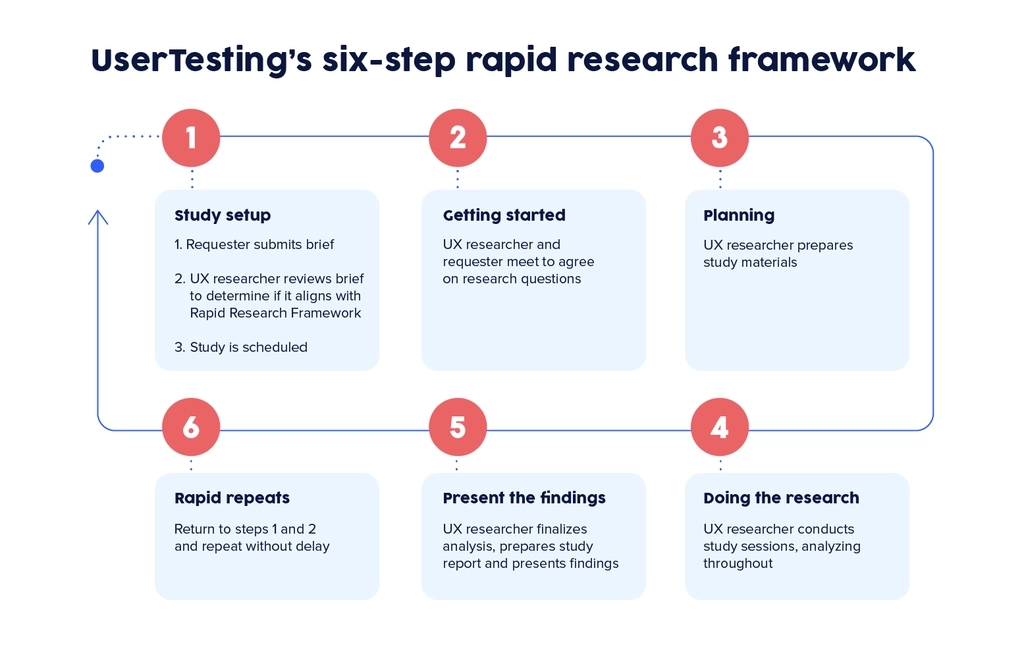
Accelerate decision-making with a rapid research framework

Good research takes intention, planning, clear goals, and proper methods. There will always be certain aspects of research that take time. But if we look at the entire research journey, from question to insight, some fluff can be eliminated. That’s why the rapid research framework was created.
A proven method for doing more research in less time
Depending on the project, it’s typical for research cycles to last weeks, months, or even longer. This is so common that it’s come to be expected by teams in different industries. Where did we get the idea that effective research must always be associated with a massive timeline?
Of course, it’s essential to be thorough and meticulous when conducting research. But if you look up those characteristics in the dictionary, you won’t find “time-intensive” anywhere in their definitions.
Instead, rapid research approaches problems with pre-designated guardrails that eliminate scope creep and time loss. This results in leaner, faster research projects from start to finish.
The main benefits of rapid research:
- More insights, delivered through multiple simultaneous studies
- More research in the same amount of time
- More time to focus on strategy
When should rapid research be used?
Rapid research is not a one-size-fits-all solution. If you’re responsible for a longitudinal multivariate global health study, rapid research probably isn’t the right approach.
Most of us, however, want to solve more straightforward problems and have deadlines more quickly. Organizations need a fast way to see if their design ideas resonate, if their prototypes are intuitive, and if their products are user-centric. For questions like these, rapid research can be your best friend.
The most common use cases for rapid research are usability and concept testing. By using well-defined frameworks, repeatable methodologies, reliable exercises, and strict time limits, validation is achieved much quicker. It’s sort of like a design sprint for research.
However, rapid research usually isn’t suitable for problems that require:
- Long surveys
- Diary studies
- Co-creation or design-thinking
- Longitudinal attitude studies
- Extended or repeated interviews
- Big data and quantitative research
- Brainstorming
- Pre-prototype testing
Rapid research framework characteristics
Rapid research works best for usability testing, and concept testing studies run with the following criteria. Every project is different, but here are some common characteristics typically used to speed up the research process.
- Individual sessions - Rapid research frameworks utilize individual testing sessions that serve a single purpose and occur within a single observable period.
- Short research sessions - Research sessions are typically capped at 30 minutes max. Longer research sessions risk upsetting the timeline.
- Structured and consistent studies - Structured and consistent studies work best instead of freeform, co-creation, or similar study group types as they can be run on a tight timeline. To ensure the consistent smooth-running of your research sessions, use a moderation guide to define the guardrails and rules.
- Qualitative studies - In most cases, qualitative is all you need to deliver solid insights. No need to extend to quantitative studies; it will only take up valuable time.
- Working prototypes - Rapid research can’t have obstacles, which means a mature, working prototype must be available for testing.
- Full team accountability - All stakeholders must be on board with the rapid research idea and the reasons for speeding up research and insight cycles. Every relevant team member should know the deadlines for feedback and delivery.
How to perform rapid research
There aren’t hard and fast rules for a rapid research framework. Different teams adapt the approach to fit their agile methodologies and internal processes. However, all implementations of rapid research share the common elements of clear milestones, repeatable steps, and a predetermined cadence.
In this section, we’ll take you through our six-step rapid research framework. But first, it’s essential to understand a helpful deliverable that makes the rapid research process run smoothly.
The 6-step rapid research process
Here’s a step-by-step visual tour of what a rapid research framework can look like.
This includes setting up the study and agreeing on the research questions, preparing materials, conducting, analyzing, presenting the findings, and repeating the process to keep your research moving at speed.

1. Study setup
The requester submits their research brief through the usual channels. The researchers review the brief and ensure the request is feasible within the rapid research framework. The project is greenlit, and researchers begin scheduling the studies.
2. Getting started
The requester and lead researcher meet to discuss the brief and their objectives and refine the questions participants will answer. This meeting should be limited to 30 minutes. That isn’t long—but this is rapid research!
3. Planning
The team creates the study materials, selects participants, and ensures all deliverables are ready.
4. Do the research
The scheduled studies are run, and results are recorded. Meanwhile, other team members work to organize and synthesize the results as they come in.
5. Present findings
The analysis is finalized and pulled into a study report or presentation. The data is presented to the requester in a 30-minute meeting to summarize the findings. During the meeting, it’s decided what product or testing tweaks are needed (if any) and what additional research is required.
6. Rapid repeats
Rapid research’s greatest strength is in its iteration. It’s essential to keep the process moving. Once the insights are gained, jump back to steps 1 and 2 and begin again. Repeat until the problem is solved, the question is answered, or the experience is complete.
Rapid research framework timeline
All organizations are different. The timeline for rapid research is flexible. But in general, the cycles repeat themselves within weeks – not months. Here are calendar examples of what a single rapid research timeline might look like and a multi-stream timeline that staggers testing to accomplish multiple projects simultaneously.

Running multiple rapid research studies
If you want to run multiple rapid research studies, you can consider staggered projects, allowing multiple studies to run in parallel.

The impact of rapid research
Rapid research has a positive effect on organizations in three key dimensions:
Speed
By systematizing the research, organizations gain the capacity to run multiple research streams simultaneously so that teams can deliver more insights faster.
Scale
With automation in recruiting and analysis, teams can dramatically increase the number of studies and interviews conducted.
Impact
Through thoughtful program design, research teams can double their foundational research capacity and be empowered to deliver strategic insights.

UX resource collection
Explore UX best practices, expert advice, user research templates, and more.





